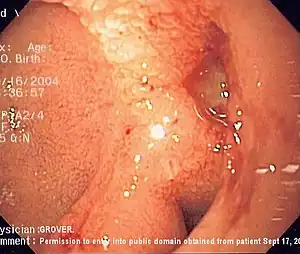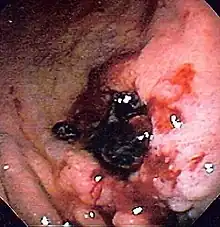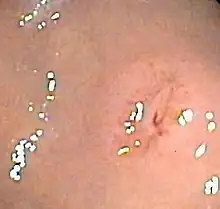Upper gastrointestinal bleeding
| Upper gastrointestinal bleeding | |
|---|---|
| Other names: Upper gastrointestinal hemorrhage, gastrorrhagia, upper GI bleed, UGI bleed | |
 | |
| Endoscopic image of a posterior wall duodenal ulcer with a clean base, a common cause of upper gastrointestinal bleeding. | |
| Specialty | Gastroenterology |
| Symptoms | Vomiting blood, black stool, abdominal pain, lightheadedness[1] |
| Complications | Shock, anemia[2] |
| Causes | Peptic ulcers, gastritis, varices, gastric cancer, Mallory-Weiss tears, vascular malformations[1][3] |
| Risk factors | Blood thinners, aspirin, NSAIDs, Helicobacter pylori, kidney failure, liver disease, prior bleeding[1][3] |
| Treatment | Fluid replacement, blood transfusion, endoscopy[3] |
| Medication | Proton pump inhibitor, octreotide[3] |
| Frequency | ~1 per 1,000 per year[1][3] |
Upper gastrointestinal bleeding is bleeding from the esophagus, stomach, or duodenum.[1] Symptoms may include vomiting blood, black stool, abdominal pain, and lightheadedness.[1] Complications may include shock and anemia.[2]
Causes include peptic ulcers, gastritis, varices, gastric cancer, Mallory-Weiss tears, and vascular malformations.[1][3] Risk factors include blood thinners, aspirin, NSAIDs, Helicobacter pylori, kidney failure, liver disease, and prior bleeding.[1][3] Diagnosis is often supported by a complete blood cell count (CBC), BUN, and endoscopy.[3]
Intravenous fluid replacement, including blood transfusion, may be required.[3] Proton pump inhibitors are generally given.[4] Endoscopy is recommended within 24 hours in those who are unstable, during which bleeding can be stopped by various techniques.[1][5] In those with varices, octreotide may be used.[3] Tranexamic acid has not be found to be useful.[6] Other options may include embolization or surgery.[1] In about 15% of people bleeding reoccurs.[3]
Upper gastrointestinal bleeding affects around 5 to 15 people per 10,000 a year.[1][3] It occurs more commonly in older people.[1] It represents over 50% of cases of gastrointestinal bleeding.[4] The risk of death is between 2 and 10%.[7]
Signs and symptoms
Persons with upper gastrointestinal bleeding often present with hematemesis, coffee ground vomiting, melena, or hematochezia (maroon-coloured stool) if the hemorrhage is severe. The presentation of bleeding depends on the amount and location of hemorrhage. A person with upper gastrointestinal bleeding may also present with complications of anemia, including chest pain, syncope, fatigue and shortness of breath.
The physical examination performed by the physician concentrates on the following things:
- Vital signs, in order to determine the severity of bleeding and the timing of intervention
- Abdominal and rectal examination, in order to determine possible causes of hemorrhage
- Assessment for portal hypertension and signs of chronic liver disease in order to determine if the bleeding is from a variceal source.
Laboratory findings include anemia, coagulopathy, and an elevated BUN-to-creatinine ratio.
Causes

A number of medications increase the risk of bleeding including NSAIDs and SSRIs. SSRIs double the rate of upper gastrointestinal bleeding.[8]
There are many causes for upper gastrointestinal hemorrhage. Causes are usually anatomically divided into their location in the upper gastrointestinal tract.
People are usually stratified into having either variceal or non-variceal sources of upper gastrointestinal hemorrhage, as the two have different treatment algorithms and prognosis.
The causes for upper gastrointestinal hemorrhage include the following:
- Esophagus:
- Esophageal varices
- Esophagitis
- Esophageal cancer
- Esophageal ulcers
- Mallory-Weiss tear
- Stomach:
- Duodenum:
- Duodenal ulcer
- Vascular malformation, including aorto-enteric fistulae. Fistulae are usually secondary to prior vascular surgery and usually occur at the proximal anastomosis at the third or fourth portion of the duodenum where it is retroperitoneal and near the aorta.[9][10][11]
- Hematobilia, or bleeding from the biliary tree
- Hemosuccus pancreaticus, or bleeding from the pancreatic duct
- Severe superior mesenteric artery syndrome
Diagnosis

The diagnosis of upper gastrointestinal bleeding is assumed when hematemesis is documented. In the absence of hematemesis, an upper source for gastrointestinal bleeding is likely in the presence of at least two factors among: black stool, age < 50 years, and blood urea nitrogen/creatinine ratio 30 or more. In the absence of these findings, consider a nasogastric aspirate to determine the source of bleeding. If the aspirate is positive, an upper gastrointestinal bleed is greater than 50%, but not high enough to be certain. If the aspirate is negative, the source of a gastrointestinal bleed is likely lower. The accuracy of the aspirate is improved by using the Gastroccult test.
Probability
The strongest predictors of an upper gastrointestinal bleed are black stool, age <50 years, and blood urea nitrogen/creatinine ratio 30 or more.[12][13]
The nasogastric aspirate can help determine the location of bleeding and thus direct initial diagnostic and treatment plans. Nasogastric aspirate has a sensitivity of 42%, specificity 91%, negative predictive value 64%, positive predictive value 92% and overall accuracy of 66% in differentiating upper gastrointestinal bleeding from bleeding distal to the ligament of Treitz.[12] A positive aspirate is more helpful than a negative aspirate. A smaller study found a sensitivity of 79% and specificity of 55%, somewhat opposite results from Witting.[14]
Determining whether blood is in gastric contents, either vomited or aspirated specimens, is difficult. Slide tests are based on orthotolidine (Hematest reagent tablets and Bili-Labstix) or guaiac (Hemoccult and Gastroccult). Rosenthal found orthotolidine-based tests more sensitive than specific; the Hemoccult test's sensitivity reduced by the acidic environment; and the Gastroccult test be the most accurate.[15] Cuellar found the following results:
| Finding | Sensitivity | Specificity | Positive predictive value (prevalence of 39%) | Negative predictive value (prevalence of 39%) |
|---|---|---|---|---|
| Gastroccult | 95% | 82% | 77% | 96% |
| Physician assessment | 79% | 55% | 53% | 20% |
Holman used simulated gastric specimens and found the Hemoccult test to have significant problems with non-specificity and false-positive results, whereas the Gastroccult test was very accurate.[16] Holman found that by 120 seconds after the developer was applied, the Hemoccult test was positive on all control samples.
A scoring system called the Glasgow-Blatchford bleeding score found 16% of people presenting with upper gastrointestinal bleed had Glasgow-Blatchford score of "0", considered low. Among these people there were no deaths or interventions needed and they were able to be effectively treated in an outpatient setting.[17][18]
Score is equal to "0" if the following are all present:
- Hemoglobin level >12.9 g/dL (men) or >11.9 g/dL (women)
- Systolic blood pressure >109 mm Hg
- Pulse <100/minute
- Blood urea nitrogen level <18.2 mg/dL
- No melena or syncope
- No past or present liver disease or heart failure
The Rockall score may also be used to predict the risk of further bleeding and death.[3]
Treatment
The initial focus is on resuscitation beginning with airway management and fluid resuscitation using either intravenous fluids and or blood.[19] A number of medications may improve outcomes depending on the source of the bleeding.[19] Although proton pump inhibitors are often given in the emergent setting, there is no evidence that these medications decrease death rates, re-bleeding events, or needs for surgical interventions.[20] Tranexamic acid has not been found to be useful.[6][21]
After the initial resuscitation, treatment is to limit the likelihood of rebleeds and correct significant anaemia that has occured. Those with a Glasgow Blatchford score less than 2 may not require admission to hospital.[22]
Peptic ulcers
Based on evidence from people with other health problems crystalloid and colloids are believed to be equivalent for peptic ulcer bleeding.[19] In people with a confirmed peptic ulcer, proton pump inhibitors (PPIs) do not reduce death rates, later bleeding events, or need for surgery.[23] They may decrease signs of bleeding at endoscopy; however, and are generally recommended at a high dose for at least 72 hours.[23][1] The effectiveness of intravenous and by mouth PPIs appear similar.[1] In those with less severe disease and where endoscopy is rapidly available, they are of less clinical importance.[24] Somatostatin and octreotide while recommended for variceal bleeding have not been found to be of general use for non-variceal bleeds.[19]
Variceal bleed

For initial fluid replacement colloids or albumin is preferred in people with cirrhosis.[19] Medications typically includes octreotide or if not available vasopressin and nitroglycerin to reduce portal pressures.[25] This is typically in addition to endoscopic banding or sclerotherapy for the varices.[25] If this is sufficient then beta blockers and nitrates may be used for the prevention of re-bleeding.[25] If bleeding continues then esophageal balloon tamponade with a Sengstaken-Blakemore tube or Minnesota tube may be used in an attempt to mechanically compress the varices.[25] This may then be followed by a transjugular intrahepatic portosystemic shunt.[25]
Blood products
If large amounts of pack red blood cells are used additional platelets and fresh frozen plasma should be administered to prevent blood clotting problems.[19] Some evidence supports holding off on blood transfusions in those who have a hemoglobin greater than 7 to 8 g/dL and only moderate bleeding.[19][26][1] If the INR is greater than 1.5 to 1.8 correction with fresh frozen plasma or prothrombin complex may decrease mortality.[19] Those with an INR of greater than 2.5, should have this addressed before endoscopy.[1]
Procedures

The benefits versus risks of placing a nasogastric tube in those with upper gastrointestingal bleeding are not determined.[19] Endoscopy within 24 hours is recommended.[19] Prokinetic agents such as erythromycin before endoscopy can decrease the amount of blood in the stomach and thus improve the operators view.[19] Early endoscopy decreases hospital time and the amount of blood transfusions needed.[19] Proton pump inhibitors, if they have not been started earlier, are recommended in those in whom high risk signs for bleeding are found.[19] It is also recommended that people with high risk signs are kept in hospital for at least 72 hours.[19] Blood is not recommended to correct anaemia, unless the patient is cardiovascularly unstable as this can worsen outcomes.[26] Oral iron can be used, but this can lead to problems with compliance, tolerance, darkening stools which may mask evidence of rebleeding and tends to be slow, especially if used in conjunction with proton pump inhibitors. Parenteral Iron is increasingly used in these cases to improve patient outcomes and void blood usage.
Prognosis
Depending on its severity, upper gastrointestinal bleeding may carry an estimated mortality risk of 11%.[27] However, survival has improved to about 2 percent, likely as a result of improvements in medical therapy and endoscopic control of bleeding.[28]
Epidemiology
About 75% of people presenting to the emergency department with gastrointestinal bleeding have an upper source .[13] The diagnosis is easier when the people have hematemesis. In the absence of hematemesis, 40% to 50% of people in the emergency department with gastrointestinal bleeding have an upper source.[12][14][29]
See also
References
- 1 2 3 4 5 6 7 8 9 10 11 12 13 14 15 16 Wilkins, T; Wheeler, B; Carpenter, M (1 March 2020). "Upper Gastrointestinal Bleeding in Adults: Evaluation and Management". American family physician. 101 (5): 294–300. PMID 32109037.
- 1 2 "Gastrointestinal bleeding - Symptoms and causes". Mayo Clinic. Archived from the original on 2 March 2021. Retrieved 9 March 2021.
- 1 2 3 4 5 6 7 8 9 10 11 12 13 Antunes, C; Copelin II, EL (January 2021). "Upper Gastrointestinal Bleeding". PMID 29262121.
{{cite journal}}: Cite journal requires|journal=(help) - 1 2 Beyda, R; Johari, D (22 July 2019). "Tranexamic acid for upper gastrointestinal bleeding". Academic Emergency Medicine. 26 (10): 1181–1182. doi:10.1111/acem.13835. PMID 31329328.
- ↑ Barkun, AN; Almadi, M; Kuipers, EJ; Laine, L; Sung, J; Tse, F; Leontiadis, GI; Abraham, NS; Calvet, X; Chan, FKL; Douketis, J; Enns, R; Gralnek, IM; Jairath, V; Jensen, D; Lau, J; Lip, GYH; Loffroy, R; Maluf-Filho, F; Meltzer, AC; Reddy, N; Saltzman, JR; Marshall, JK; Bardou, M (22 October 2019). "Management of Nonvariceal Upper Gastrointestinal Bleeding: Guideline Recommendations From the International Consensus Group". Annals of Internal Medicine. 171 (11): 805–822. doi:10.7326/M19-1795. PMC 7233308. PMID 31634917.
- 1 2 Kamal, F; Khan, MA; Lee-Smith, W; Sharma, S; Imam, Z; Jowhar, D; Petryna, E; Marella, HK; Aksionav, P; Iqbal, U; Tombazzi, C; Howden, CW (December 2020). "Efficacy and safety of tranexamic acid in acute upper gastrointestinal bleeding: meta-analysis of randomised controlled trials". Scandinavian journal of gastroenterology. 55 (12): 1390–1397. doi:10.1080/00365521.2020.1839963. PMID 33112175.
- ↑ Stanley, Adrian J; Laine, Loren (25 March 2019). "Management of acute upper gastrointestinal bleeding". BMJ: l536. doi:10.1136/bmj.l536.
- ↑ "Are SSRIs associated with upper gastrointestinal bleeding in adults?". Global Family Doctor. Archived from the original on 2011-07-11. Retrieved 2010-11-24.
- ↑ Graber CJ, et al. (2007). "A Stitch in Time — A 64-year-old man with a history of coronary artery disease and peripheral vascular disease was admitted to the hospital with a several-month history of fevers, chills, and fatigue". N Engl J Med. 357 (10): 1029–34. doi:10.1056/NEJMcps062601. PMID 17804848.
- ↑ Sierra J, Kalangos A, Faidutti B, Christenson JT; Kalangos; Faidutti; Christenson (2003). "Aorto-enteric fistula is a serious complication to aortic surgery. Modern trends in diagnosis and therapy". Cardiovascular Surgery (London, England). 11 (3): 185–8. doi:10.1016/S0967-2109(03)00004-8. PMID 12704326.
{{cite journal}}: CS1 maint: multiple names: authors list (link) - ↑ Cendan JC, Thomas JB, Seeger JM; Thomas Jb; Seeger (2004). "Twenty-one cases of aortoenteric fistula: lessons for the general surgeon". The American Surgeon. 70 (7): 583–7, discussion 587. PMID 15279179.
{{cite journal}}: CS1 maint: multiple names: authors list (link) - 1 2 3 Witting MD, Magder L, Heins AE, Mattu A, Granja CA, Baumgarten M; Magder; Heins; Mattu; Granja; Baumgarten (2006). "ED predictors of upper gastrointestinal tract bleeding in patients without hematemesis". Am J Emerg Med. 24 (3): 280–5. doi:10.1016/j.ajem.2005.11.005. PMID 16635697.
{{cite journal}}: CS1 maint: multiple names: authors list (link) - 1 2 Ernst AA, Haynes ML, Nick TG, Weiss SJ; Haynes; Nick; Weiss (1999). "Usefulness of the blood urea nitrogen/creatinine ratio in gastrointestinal bleeding". Am J Emerg Med. 17 (1): 70–2. doi:10.1016/S0735-6757(99)90021-9. PMID 9928705.
{{cite journal}}: CS1 maint: multiple names: authors list (link) - 1 2 3 Cuellar RE, Gavaler JS, Alexander JA, et al. (1990). "Gastrointestinal tract hemorrhage. The value of a nasogastric aspirate". Archives of Internal Medicine. 150 (7): 1381–4. doi:10.1001/archinte.150.7.1381. PMID 2196022.
- ↑ Rosenthal P, Thompson J, Singh M; Thompson; Singh (1984). "Detection of occult blood in gastric juice". J. Clin. Gastroenterol. 6 (2): 119–21. doi:10.1097/00004836-198404000-00004. PMID 6715849.
{{cite journal}}: CS1 maint: multiple names: authors list (link) - ↑ Holman JS, Shwed JA; Shwed (1992). "Influence of sucralfate on the detection of occult blood in simulated gastric fluid by two screening tests". Clin Pharm. 11 (7): 625–7. PMID 1617913.
- ↑ Stanley AJ, Ashley D, Dalton HR, et al. (January 2009). "Outpatient management of patients with low-risk upper-gastrointestinal haemorrhage: multicentre validation and prospective evaluation". Lancet. 373 (9657): 42–7. doi:10.1016/S0140-6736(08)61769-9. PMID 19091393. S2CID 1738579. Lay summary.
{{cite journal}}: Cite uses deprecated parameter|lay-url=(help) - ↑ "Glasgow-Blatchford bleeding score". Archived from the original on 2017-07-14. Retrieved 2009-01-24.
- 1 2 3 4 5 6 7 8 9 10 11 12 13 14 Jairath, V; Barkun, AN (October 2011). "The overall approach to the management of upper gastrointestinal bleeding". Gastrointestinal Endoscopy Clinics of North America. 21 (4): 657–70. doi:10.1016/j.giec.2011.07.001. PMID 21944416.
- ↑ Sreedharan, A; Martin, J; Leontiadis, GI; Dorward, S; Howden, CW; Forman, D; Moayyedi, P (7 July 2010). "Proton pump inhibitor treatment initiated prior to endoscopic diagnosis in upper gastrointestinal bleeding". The Cochrane Database of Systematic Reviews (7): CD005415. doi:10.1002/14651858.CD005415.pub3. PMC 6769021. PMID 20614440.
- ↑ Ton, Joey (19 April 2022). "#313 Gastrointestinal bleeding - Does tranexamic acid halt it or not?". CFPCLearn. Archived from the original on 1 July 2023. Retrieved 14 June 2023.
- ↑ Barkun, Alan N.; Almadi, Majid; Kuipers, Ernst J.; Laine, Loren; Sung, Joseph; Tse, Frances; Leontiadis, Grigorios I.; Abraham, Neena S.; Calvet, Xavier; Chan, Francis K.L.; Douketis, James; Enns, Robert; Gralnek, Ian M.; Jairath, Vipul; Jensen, Dennis; Lau, James; Lip, Gregory Y.H.; Loffroy, Romaric; Maluf-Filho, Fauze; Meltzer, Andrew C.; Reddy, Nageshwar; Saltzman, John R.; Marshall, John K.; Bardou, Marc (22 October 2019). "Management of Nonvariceal Upper Gastrointestinal Bleeding: Guideline Recommendations From the International Consensus Group". Annals of Internal Medicine. 171 (11): 805–822. doi:10.7326/M19-1795. PMC 7233308. PMID 31634917.
- 1 2 Serpico, M; Riscinti, M (6 December 2019). "Proton Pump Inhibitors for Acute Upper Gastrointestinal Bleeding". Academic Emergency Medicine. 27 (4): 336–338. doi:10.1111/acem.13899. PMID 31808973.
- ↑ Sreedharan, A; Martin, J; Leontiadis, GI; Dorward, S; Howden, CW; Forman, D; Moayyedi, P (2010-07-07). Sreedharan, Aravamuthan (ed.). "Proton pump inhibitor treatment initiated prior to endoscopic diagnosis in upper gastrointestinal bleeding". Cochrane Database of Systematic Reviews (7): CD005415. doi:10.1002/14651858.CD005415.pub3. PMC 6769021. PMID 20614440.
- 1 2 3 4 5 Cat, TB; Liu-DeRyke, X (September 2010). "Medical management of variceal hemorrhage". Critical Care Nursing Clinics of North America. 22 (3): 381–93. doi:10.1016/j.ccell.2010.02.004. PMID 20691388.
- 1 2 Villanueva, Càndid; Colomo, Alan; Bosch, Alba; Concepción, Mar; Hernandez-Gea, Virginia; Aracil, Carles; Graupera, Isabel; Poca, María; et al. (2013). "Transfusion Strategies for Acute Upper Gastrointestinal Bleeding". New England Journal of Medicine. 368 (1): 11–21. doi:10.1056/NEJMoa1211801. PMID 23281973.
- ↑ British Society of Gastroenterology Endoscopy Committee (October 2002). "Non-variceal upper gastrointestinal haemorrhage: guidelines". Gut. 51 Suppl 4: iv1–6. doi:10.1136/gut.51.suppl_4.iv1 (inactive 2021-01-15). PMC 1867732. PMID 12208839. Archived from the original on 2021-08-29. Retrieved 2013-12-25.
{{cite journal}}: CS1 maint: DOI inactive as of January 2021 (link) - ↑ Cai, Jennifer X.; Saltzman, John R. (July 2018). "Initial Assessment, Risk Stratification, and Early Management of Acute Nonvariceal Upper Gastrointestinal Hemorrhage". Gastrointestinal Endoscopy Clinics of North America. 28 (3): 261–275. doi:10.1016/j.giec.2018.02.001. PMID 29933774.
- ↑ Witting MD, Magder L, Heins AE, Mattu A, Granja CA, Baumgarten M; Magder; Heins; Mattu; Granja; Baumgarten (2004). "Usefulness and validity of diagnostic nasogastric aspiration in patients without hematemesis". Ann Emerg Med. 43 (4): 525–32. doi:10.1016/j.annemergmed.2003.09.002. PMID 15039700.
{{cite journal}}: CS1 maint: multiple names: authors list (link)
External links
- Patient.uk Archived 2021-08-27 at the Wayback Machine
| Classification | |
|---|---|
| External resources |